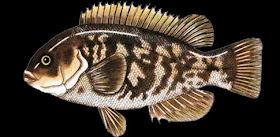The Blue Shark or Prionace glauca are from the Carcharhinidae family which also includes the Tiger Shark, Bull Shark and the Milk Shark. Blue Sharks are often called the wolves of the sea because they will form schools based on sex and size. These sharks are often found in tropical areas and even have been located in some brackish waters up to 350 meters deep worldwide in tropical and temperate waters. You can check out the Blue Shark underwater in the video below...
Blue sharks have a blue colored body with long pectoral fins and a white underbelly. These sharks are large, growing to 12-1/2 feet (3.8 meters) and weighing in at 862lbs (391 kg). These sharks have been known to dine on squid as well as shrimp, smaller sharks, cuttlefish, octopuses and even a few unlucky sea birds.
Like many other sharks, Blue Sharks are viviparous which mean that they have live birth instead of laying eggs. One Blue Shark can produce over 100 pups in one cycle! It takes about 11 months for the pups to develop in a female that is at least 5 years of age. Blue Sharks have a rather odd way of mating which includes the male biting the female. I guess they like it rough! For this reason the female of this species have skin that is 3 times as thick as their male counterparts.
If you have any additional information about the Blue Shark please leave us a comment below.
Tautog (Tautoga onitis)
The Tautog or Tautoga onitis is a saltwater fish that is often sought after by anglers from Nova Scotia to Georgia in the Atlantic Ocean. This fish from the Wrasse family is often found in a bottom that has structure, like ship wrecks, rocks or mussel beds. This rough territory make it easy for a Tautog to tangle the anglers line and break free.
Also known as the Blackfish, they are brown or dark olive with white blotches. Tautog can grow to about 3' (1m) and can weigh up to 25lbs. These fish have powerful jaws and two sets of teeth, one in the front and one in the back of their throat that helps them to crush crustaceans and mollusks of all sorts. They also have a slime of sorts that covers their bodies, much like some Northern Pike. This helps them glide off sharp rocks that they may encounter while swimming.
When fishing for a Tautog it is critical that you wait a moment to set the hook as you almost need to wait for the Tautog to swallow the bait before you can hook them. Popular baits for Tautog include crabs, clams, shrimp, sandworms and even lobster. Spearfishing is another way to catch the elusive Tautog. They are said to be quite calm around scuba divers. You can check them out underwater in the video below...
Spawning of the Tautog will often happen in the late spring or early summer in an offshore location. Once hatched the little ones will often take shelter in seaweed until they are large enough to venture out on their own into the big water. Because of the relatively slow reproduction rate of the Tautog, these fish are very vulnerable to overfishing. Please practice catch and release when possible.
If you have any additional information about the Tautog please leave us a comment below.
Also known as the Blackfish, they are brown or dark olive with white blotches. Tautog can grow to about 3' (1m) and can weigh up to 25lbs. These fish have powerful jaws and two sets of teeth, one in the front and one in the back of their throat that helps them to crush crustaceans and mollusks of all sorts. They also have a slime of sorts that covers their bodies, much like some Northern Pike. This helps them glide off sharp rocks that they may encounter while swimming.
When fishing for a Tautog it is critical that you wait a moment to set the hook as you almost need to wait for the Tautog to swallow the bait before you can hook them. Popular baits for Tautog include crabs, clams, shrimp, sandworms and even lobster. Spearfishing is another way to catch the elusive Tautog. They are said to be quite calm around scuba divers. You can check them out underwater in the video below...
Spawning of the Tautog will often happen in the late spring or early summer in an offshore location. Once hatched the little ones will often take shelter in seaweed until they are large enough to venture out on their own into the big water. Because of the relatively slow reproduction rate of the Tautog, these fish are very vulnerable to overfishing. Please practice catch and release when possible.
If you have any additional information about the Tautog please leave us a comment below.








